A strong back says a lot about your training. Since you need a strong back for heavy pulling, pressing, and everything in between, it makes sense to train your back. The seated cable row is a back isolation exercise that can be a great exercise to increase back size, strength and improve your back’s ability to stay strong under heavy loads.
Because it is a horizontal pull — performed with cables or a machine — the seated cable row gives you the opportunity to develop your horizontal pulling strength. But with this move, you don’t add extra stress to the lower back (unlike bent-over barbell rows). It’s also not limited by hamstring flexibility. While other rowing movements certainly have their place in a good training program, there are a lot of benefits to isolated rowing movements where you don’t need to support your lower back or hold yourself in bent-over positions.
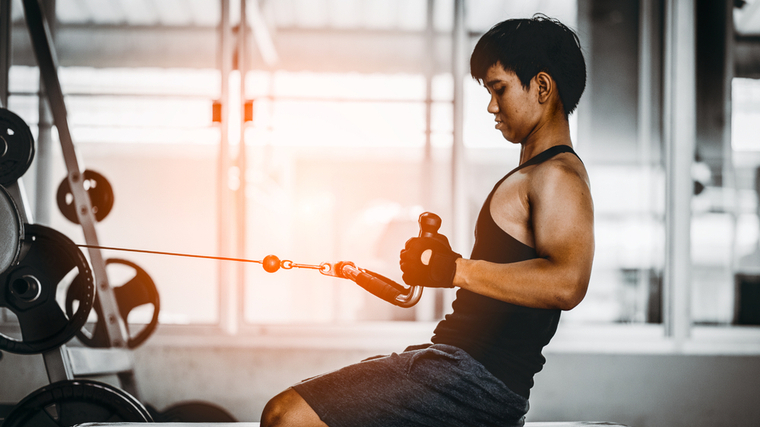
In this article, you’ll learn all about how to properly perform the seated cable row. You’ll also learn the benefits of the seated cable row, how to program them for muscle growth and back strength, and what variations and alternatives are best for improving pulling performance.
- How to Do the Seated Cable Row
- Benefits of the Seated Cable Row
- Muscles Worked by the Seated Cable Row
- Who Should Do the Seated Cable Row
- Seated Cable Row Sets and Reps
- Seated Cable Row Variations
- Seated Cable Row Alternatives
- Frequently Asked Questions
How to Do the Seated Cable Row
The seated cable row is a machine or cable-based exercise that is similar to most rows, in that it targets the back muscles. Yet, you don’t have to support your lower back since you won’t be in a bent-over position. This makes it a great exercise to attack the back using high volume without adding extra fatigue to the lower back.
Below is a step-by-step guide on how to perform the seated cable row. This particular exercise guide will describe the neutral, narrow-grip attachment.
Step 1 — Set Yourself Up
Start by taking a seat on the bench, facing the cable stack. Grab the handles. Extend your legs so your hips are far back on the bench. Bend your knees slightly with a flat lower back. Allow your upper torso to lean forward slightly.
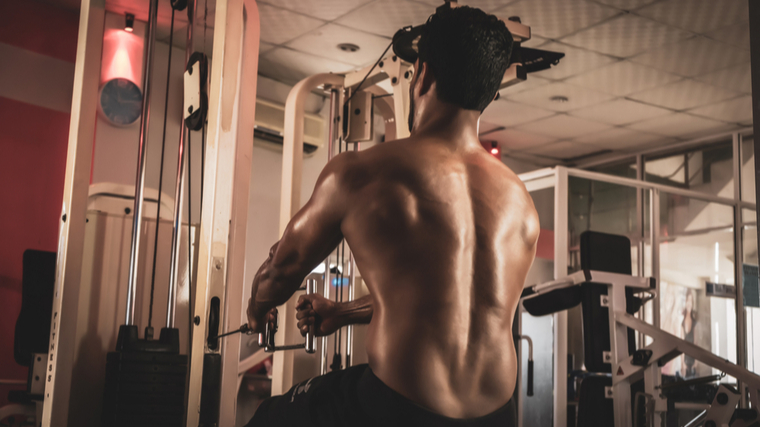
Coach’s Tip: Think about keeping your hips as far back as you can on the bench. Still, allow your upper body to reach forwards as far as possible to get a big stretch in your back.
Step 2 — Stabilize and Pull
With your body set up and arms extended in front of you, pull your elbows back. Don’t lean back too far or let your back lose its arch as you pull the weight back into your body.
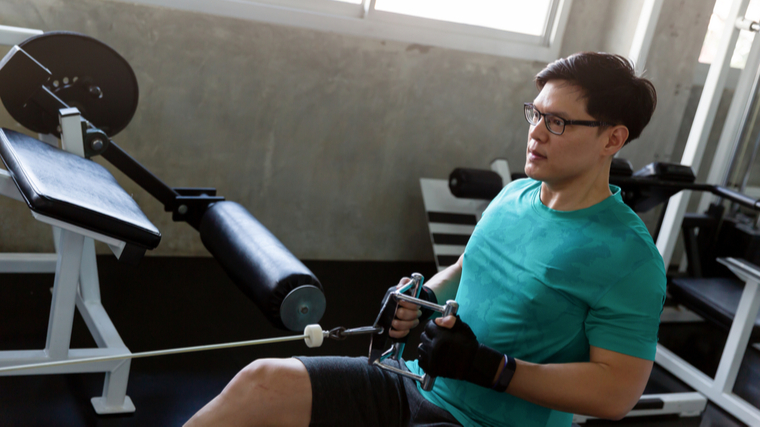
Coach’s Tip: Avoid losing tension in your lower back or letting your chest flare as you row.
Step 3 — Reach Forward and Repeat
Once you have contracted your back muscles, reach forward. Allow your torso to move forward slightly, aiming for another big stretch in your back. Repeat this process for reps.
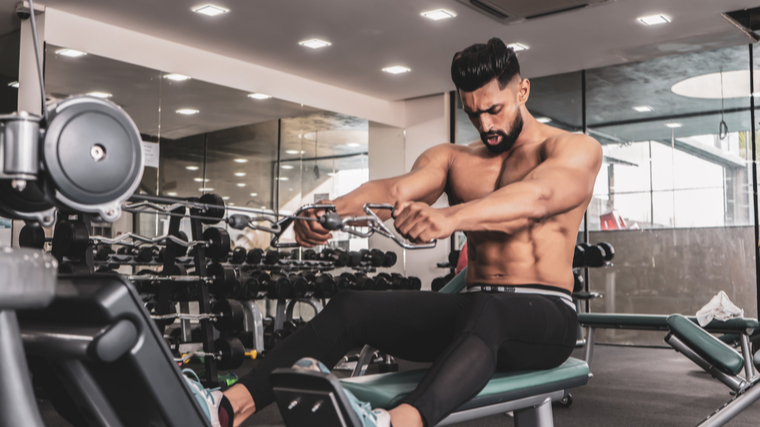
Coach’s Tip: To maximize muscle growth, think about big ranges of motion with the row, specifically the stretch (reaching forward). Keep your lower back arched and your chest up throughout the row.
Benefits of the Seated Cable Row
The seated cable row is a great back isolation exercise that can help build back thickness and strength. It also minimizes added stress and fatigue to the lower back and hamstrings. Sometimes it is helpful to not perform heavy compound movements like barbell bent-over rows, especially when your lower back, hips, and hamstrings are fatigued. Seated cable rows can give you a more isolated approach to increasing hypertrophy of the back muscles.
Build a Bigger, Thicker Back
If you are looking to grow a thick back, look no further than the seated cable row. A strong back improves nearly every lift, and is a great way to protect your spine from injury. Seated cable rows add back training volume without extra stress and fatigue to the hamstrings, lower back, and hips (and often use less weight).
[Read More: Best Lower Back Exercises for Strength and Reduced Pain]
Increased Range of Motion
There is no doubt that you can train a huge range of motion with the bent over row, especially if you stand on plates to create a deficit (increased range of motion). However, that requires good hamstring flexibility and postural awareness, which may be difficult for some lifters.
The seated cable row allows you to train a huge range of motion — which is key for optimizing muscle growth. But with this move, you don’t need tons of hamstring flexibility and postural control.
Muscles Worked by the Seated Cable Row
If you perform seated rows correctly, the majority of the tension should go to your back. While you may feel your arms, grip, and even other areas, the primary muscle group used is the lats. The sole focus is to isolate them more than any other muscle.
Latissimus Dorsi
You can develop the biggest lats with vertical and horizontal pulling movements. Rows are horizontal pulling movements that can help build a bigger back. The seated cable row, when done properly, should effectively target the back muscles.
Biceps Brachii
All rows work your arms to some degree. That said, they aren’t the primary mover and can sometimes overtake your back. If you are feeling your biceps working to a high degree, or they are becoming pumped up, you may be relying too much on arm strength.
In that case, focus more on using your back muscles as much as you can. Unwrap your thumb for a thumbless grip. Focus on keeping your chest up and lower back arched, with the elbows tucked into your body as you row.
Trapezius
Your middle and lower traps assist your lats when pulling the weight toward your ribcage. Although vertical pulls like the shrug or even power clean will work your traps more directly, they do get some auxiliary stimulation during the seated row.
Who Should Do the Seated Cable Row
Seated cable rows are a great exercise for all lifters, regardless of sport or training level.
Strength, Power, and Fitness Athletes
The seated cable row can help you build a stronger back. Like other rowing movements, the seated cable row can be used to develop a strong, balanced back. As such, it can aid in injury prevention, pulling strength, and increase lean muscle mass.
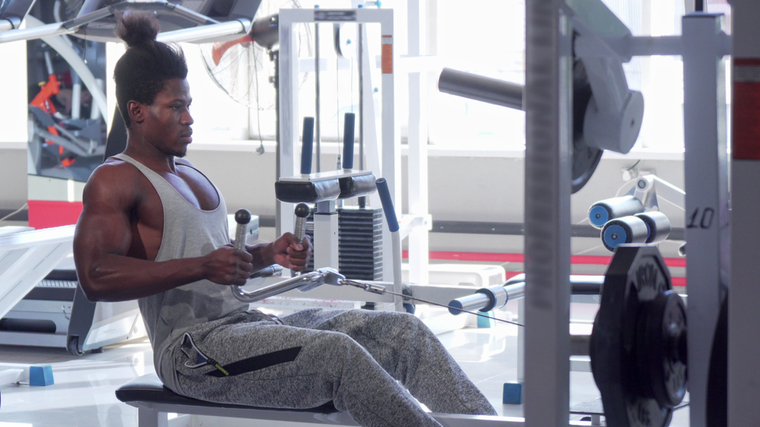
Whether you are a powerlifter, weightlifter, or CrossFitter, adding seated cable rows into your training allows you to train the back in high volume. But, you won’t be adding unnecessary fatigue to your lower back and hamstrings.
Regular Gymgoers
The seated cable row is a good exercise to help build the back for all levels of training. When done properly, it can help new lifters learn what it feels like to use their lats (rather than their arms). In addition, all the other benefits of the seated cable row apply to regular gymgoers.
Seated Cable Row Sets and Reps
If you are looking to build a more muscular back and improve back strength, the seated cable row can be a great addition to your workout routine. While this exercise is often not a main lift or a lift trained for maximal strength, you can still use heavy, moderate, and even lighter loads to stimulate muscle growth.
To Build Muscle Mass
One of the main reasons to perform the seated cable row is to build a bigger, more developed back. To build a bigger back, high volume is the key, which means performing many sets and reps, with heavy to moderate loads, to failure.
Start by programming three to five sets of 10 to 15 repetitions with moderate to heavy loads OR two to four sets of 15 to 25 repetitions with moderate loads to near failure. Keep rest periods between 45 and 90 seconds.
You can build muscle with both higher and moderate rep ranges. The key thing is to train to near failure or failure, especially if the weights are lighter!
To Increase Strength
You can use the seated cable row to build general back strength. However, it’s not something that should be trained so heavy that you need to perform extremely low reps. If you are looking to build a stronger back, you may want to look at using a barbell bent over rows, deadlifts, or carries. Then, use heavier to moderate weights in the rep ranges of five to 10 to build general strength and muscle.
Start by programming three to five sets of five to 10 repetitions with heavy loading, resting as needed.
Avoid using excessive momentum on these. You still want to focus on good technique and training to near failure or to failure.
Seated Cable Row Variations
The seated cable row can be done with a variety of handles to mix up the grip and slightly emphasize different areas of the back. Below are just a few seated cable row variations you can do by quickly swapping out the attachment handles.
Wide-Grip Seated Cable Row
The wide-grip seated cable row is done with either a straight bar, or a wide, neutral-grip handle. Each of these can help increase back width and size, as they place the arms wider out from the body.
This is also a good way to target more of the upper back and rear delts, as your elbows are flared out more to the sides.
Underhand-Grip Seated Cable Row
The underhand-grip seated cable row is a variation that can help attack the lats. For some lifters, it may be a better isolated movement than others.
By taking an underhand grip, you may get slightly more rear delt involvement and take some pressure off your shoulders.
One-Arm Seated Cable Row
You can do this with the narrow neutral-grip handles or a single-handle attachment. The one-arm seated cable row allows you to get a huge flat stretch on one side of the body. When training unilaterally, many lifters find they are able to get a better muscle contraction while evening out potential imbalances.
If you do perform one-arm seated cable rows, be sure to not allow the body to twist or rotate too much. However, you can reach forward slightly with the rowing arm. Finding that balance will help develop your anti-rotational core strength, too.
Seated Cable Row Alternatives
In the event you do not have a cable, or are seeking more variety, look no further than these seated cable row alternatives. These alternatives also limit the overall systematic fatigue and flexibility needs of movements like barbell bent-over rows and other self-supported rowing movements.
Machine Row
The machine row is not performed on a rower — rather, it’s a weight machine that you do rows on. Usually, these machines will have you seated. The nice thing about the machine is that it only allows you to perform the row on a predetermined path. So, you won’t have to worry as much about stability.
You can use whichever grip you would like, as most machine rows have various hand placements.
Chest-Supported Row
The chest-supported row can come in many forms. Some, like the seal row, are a free weight row that you perform lying on a bench. You’ll focus on pulling the load upwards. You perform others, like the T-bar row, on an angle.
All supported rows have something that supports your chest as you perform the row. This means that you don’t need to hold your back or body in position. You can isolate your back without limitations from lower back strength or hamstring flexibility.
One-Arm Dumbbell Row
The one-arm dumbbell row is similar to the one-arm seated cable row, in that it has the ability to promote a huge range of motion and stretch on the lat. You can also train this move with heavy or with high reps.
This is an iconic muscle-building back exercise. When done properly, it should be a staple of every back program.
Final Word
The seated cable row is a valuable back exercise. You can train it in a variety of rep ranges. It’s useful for all levels of athletes. When performing the seated cable row, it is best to train it with moderate to heavy loads to near failure.
Or, you can opt for moderate to lighter loads to failure for the best back growth. When paired with heavy compound pulling exercises like deadlifts, bent-over rows, chin-ups, and pull-ups, the seated cable row can be a powerful stimulus to fully develop your back muscles.
FAQs
Why should I train the seated cable row?
You might also have issues targeting your lats with heavier exercises like bent-over rows, pull-ups, or chin-ups. You can train the seated cable row in a variety of rep ranges depending on what feels best for you.
Should you do seated cable rows if you are good at barbell bent-over rows?
Yes. Adding seated cable rows later in workouts, after heavier barbell rows, is a great way to add extra volume to your back and stimulate more muscle growth. These rows let you do that without adding all the extra stress and fatigue to your lower back.
Is it okay to round the upper back during a seated cable row?
Thoracic flexion is when you allow the upper half of the back to round. It’s caused by protracting your shoulder blades and lengthening your back muscles.
A slight upper back rounding when you are reaching the arms out front (with load) can increase the stretch on your lats. As you pull the weight into your body, take the upper back from a rounded position to an arched position to get a full muscle contraction. Just be sure to not let the lower back round too much.
Featured Image: Day Of Victory Studio / Shutterstock